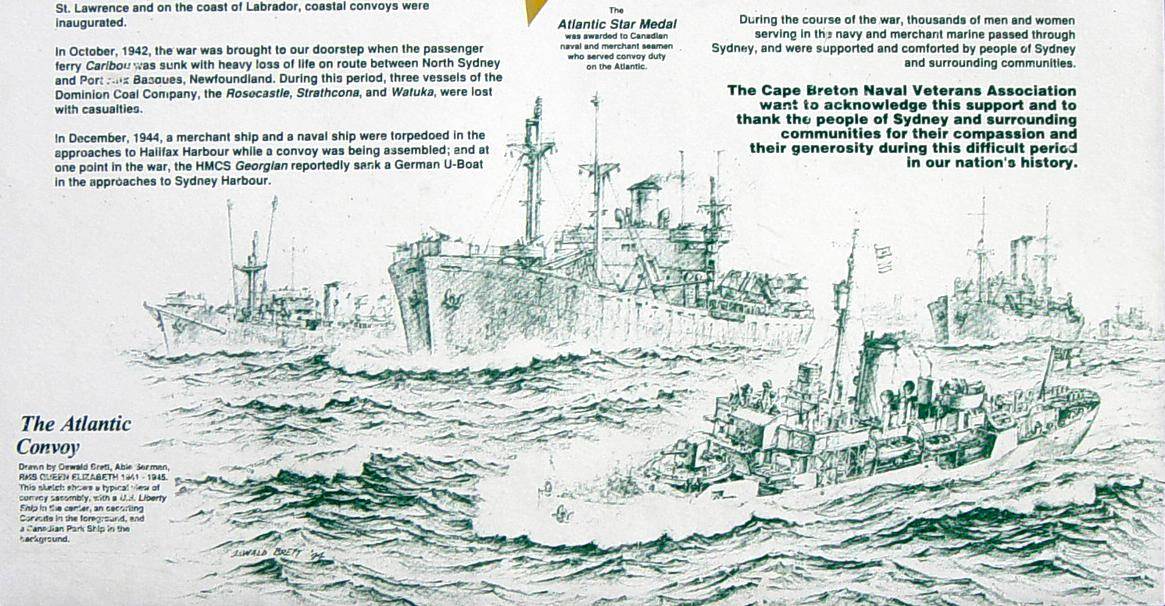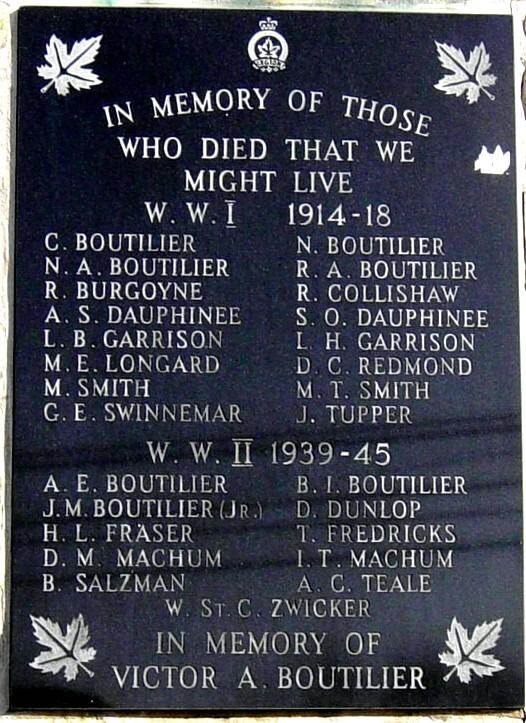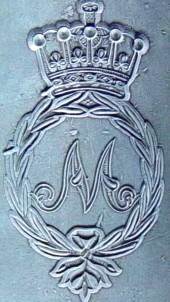
Photographs of
Chester Bronze Cannons
Cast bronze
Chester Lunenburg County Nova Scotia
Located beside the War Memorial on the Parade,
South Street at Central Street
GPS location: 44°32’11″N 64°14’33″W
North Cannon
Manufactured 1813
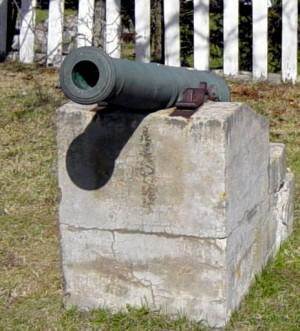
North cannon
Photographed on 30 April 2003
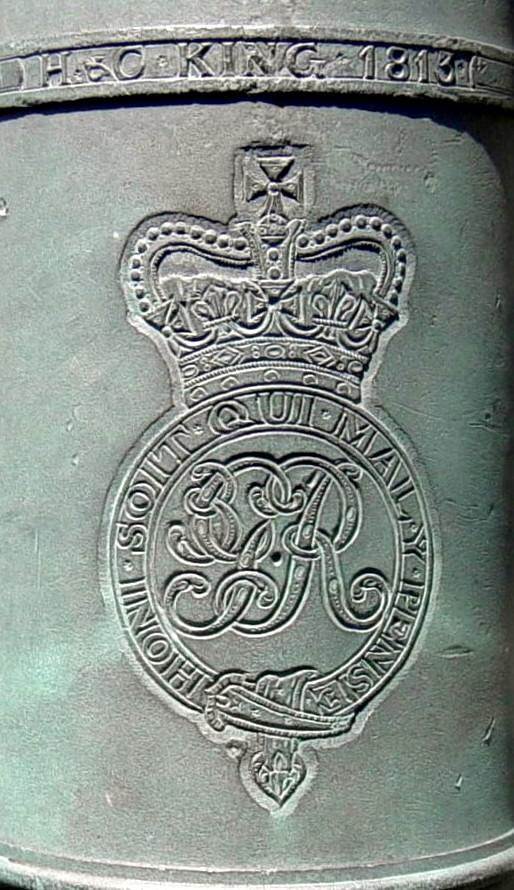
Detail of north cannon
Cast by
for
(King George III reigned 1760-1820)
Photographed on 30 April 2003

North cannon detail
Photographed on 30 April 2003
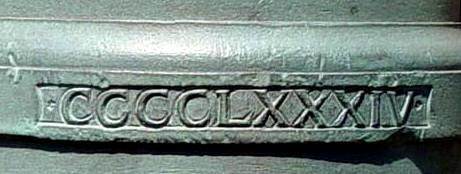
North cannon: serial number 484
Photographed on 30 April 2003
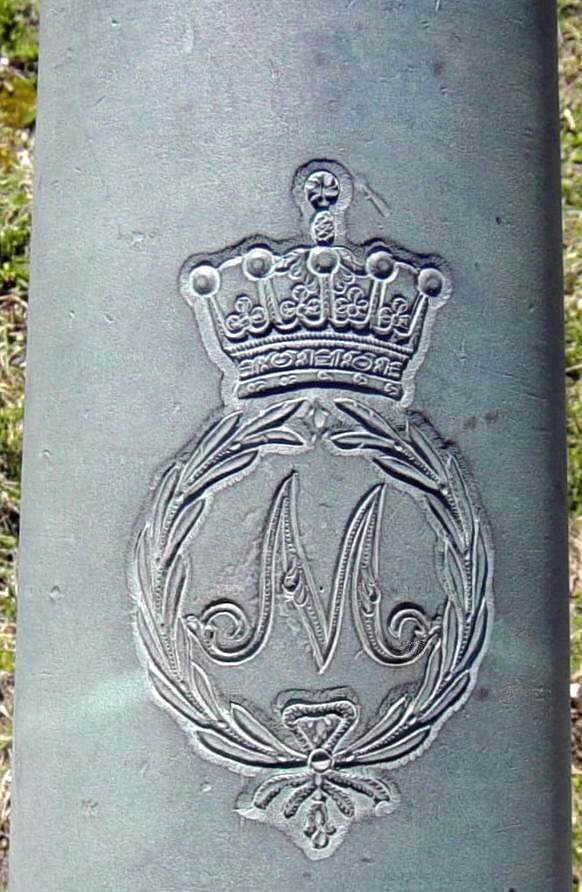
North cannon detail
This pattern on the barrel represents Henry Phipps,
Master General of the Ordnance 1810-1818
Photographed on 30 April 2003
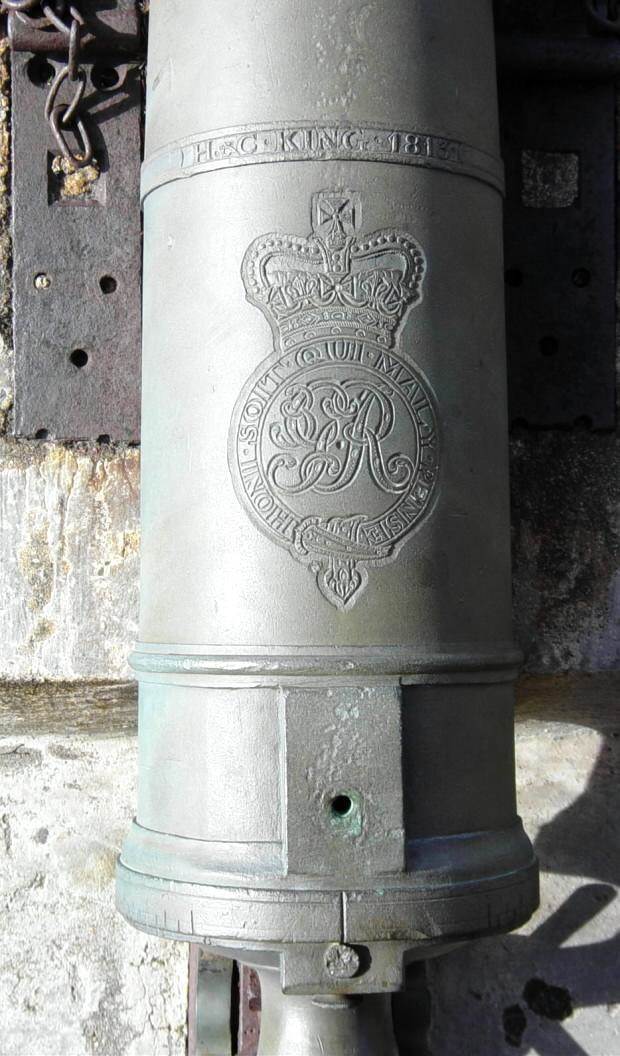
North cannon detail
Photographed on 4 November 2002
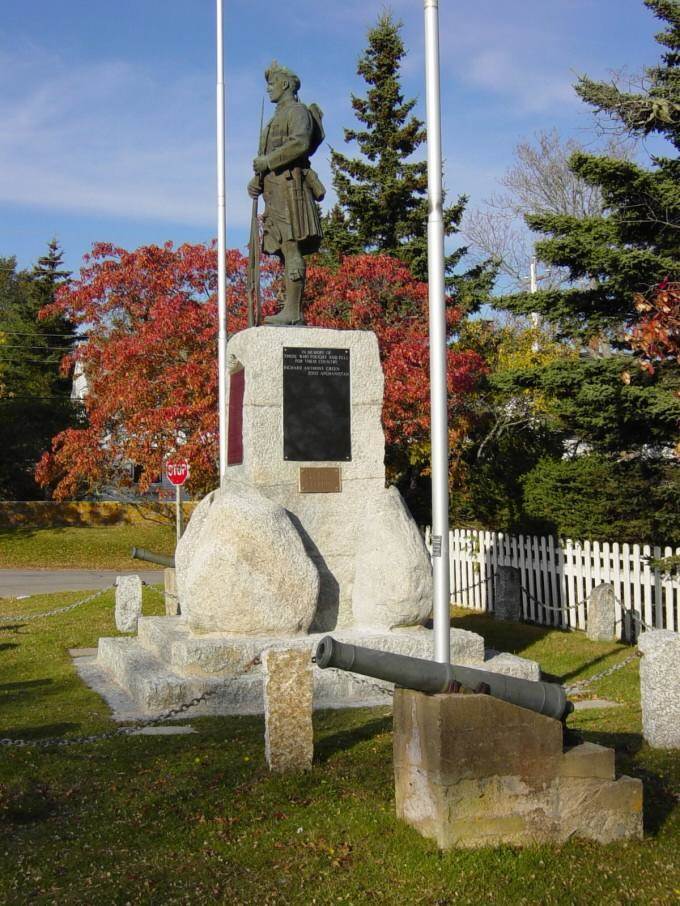
The north cannon (far) and the south cannon (near)
Photographed on 31 October 2002
Note: This photograph was taken eleven days before the
the official unveiling of the plaque facing the camera.
Also see: Chester War Memorial
Research Report on
Two Bronze Cannons
Chester, Lunenburg County, Nova Scotia
March 2004
There are three separate markings, cast into three different
positions on the cannons’ barrels. These reflect the differing
hierarchies of ownership and responsibility for the issue and
manufacture of the cannon and can be separately described
and reported on, as follows:
Conclusion
Because Henry and Cornelius King were Master Founder and
Assistant Founder at the Royal Brass Foundry between 1813
and 1818, and because Henry Phipps, as Earl of Mulgrave,
was Master General of the Ordnance at the same time, all
cannon cast at Woolwich between 1813 and 1818 should bear
the same combination of markings as those demonstrated on
these two examples.
These two cannon at Chester in Nova Scotia, and especially
that cast in 1813, will be among the earliest cannon cast by
the partnership of Henry and Cornelius King.
It must be remembered that during the War of 1812-1814 with
the United States of America, Britain was also fully engaged
in a war with Napoleonic France: thus, the outbreak of war
with the USA in 1812 would have necessitated the casting of
additional cannon. It is probable that these two cannon were
cast for the war in North America in 1812-1814.
— Research report by Stephen Wood, 1 March 2004
Stephen Wood Research, 24 Stanley Street
Southsea, Hampshire PO5 2DS, United Kingdom
References:
Blackmore, H.D., The Armouries of the Tower of London: The Ordnance.
(London, 1976)
Hogg, O.F.G., Forerunners of the Army Council,
in Journal of the Society for Army Historical Research
volume XI (1932) pages 101-148
Thorne, R.G., The House of Commons 1790-1820, volume IV
(London, 1986)
Thanks to Mr. Peter Finer Ilmington, Warwickshire, England
South Cannon
Manufactured 1814
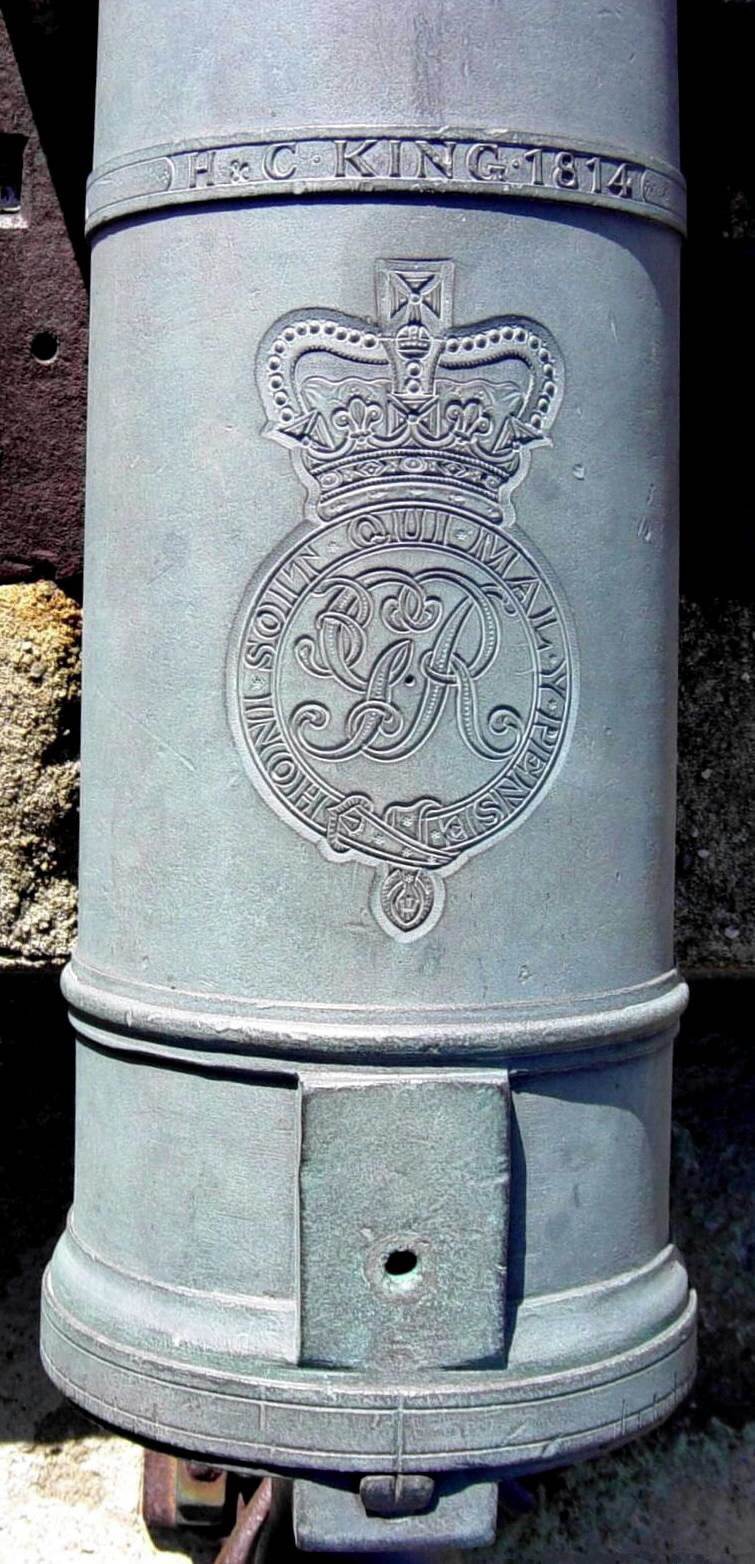
Detail of south cannon
Cast by
for
Photographed on 30 April 2003
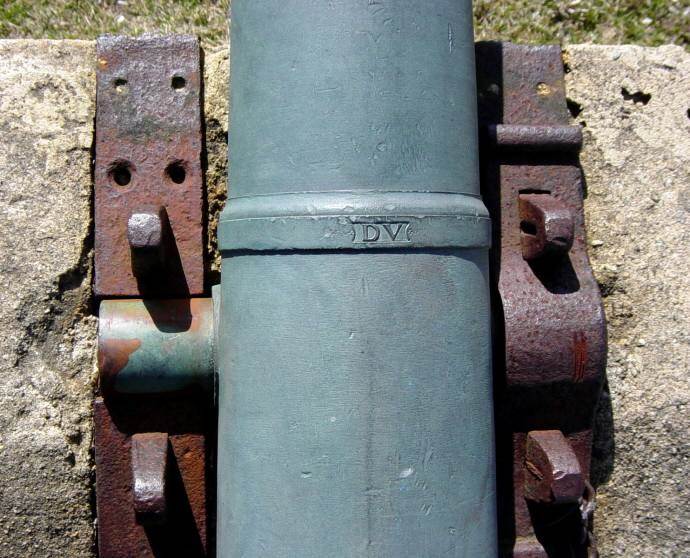
South cannon detail
Photographed on 30 April 2003
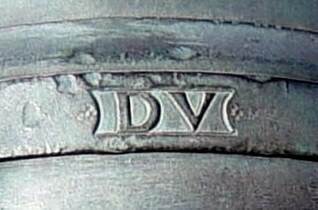
South cannon, serial number 505
Photographed on 20 March 2003
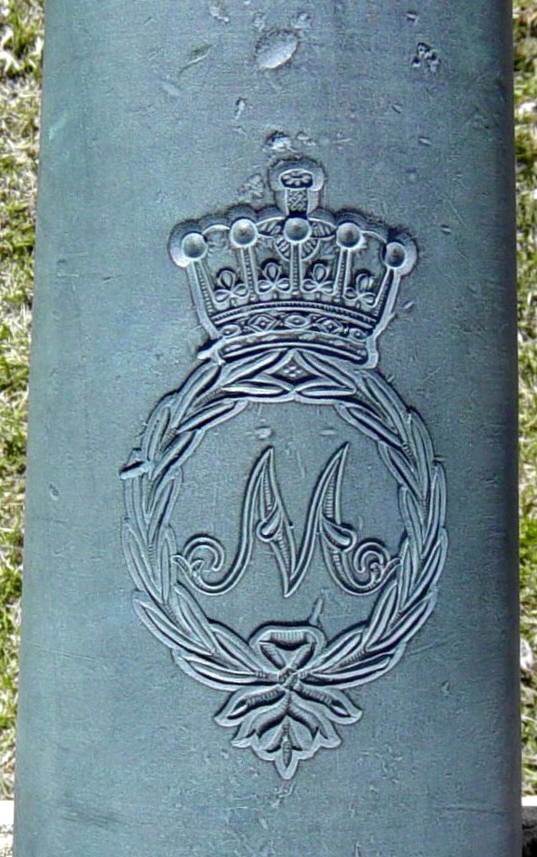
South cannon detail
This pattern on the barrel represents Henry Phipps,
Master General of the Ordnance 1810-1818
Photographed on 30 April 2003
Other Old Cannons in Nova Scotia
Bronze
Bronze is an alloy of copper and tin commonly used in
18th and 19th century artillery. Often mistakenly called brass.
Brass versus Bronze
BRASS: An alloy composed of copper and zinc
and not suitable for ordnance.
BRONZE: An alloy composed of copper and tin
and definitely suitable for ordnance.
Bronze
A metal made of two or more pure metals (pure chemical elements),
mixed and melted together, is called an alloy.
Any alloy, or mixture, of copper and tin is called bronze.
Many bronze alloys also contain small amounts of other materials.
Bronze was one of the first alloys developed by metal workers
in ancient times. The Mesopotamians ushered in the Age of Bronze
about 4500 years ago. In the earliest fortified towns bronze was
used for shields, helmets, and battle axes.
4000 years ago the Chinese made early coins of bronze.
Bronze melts at a lower temperature than iron, reducing the
manufacturing cost. Bronze is softer and weaker than iron,
but bronze resists corrosion (especially seawater corrosion)
and metal fatigue better than iron. Because it does not rust,
bronze was preferred aboard ship or in seacoast forts.
Originally “bronze” was a term for copper alloys having
tin as the only or principal alloying element. In modern usage the
name “Bronze” is seldom used alone, and a term such as
“Phosphor Bronze” or “Aluminum Bronze” is used for
identifying alloys of copper and tin with small amounts of other
elements added to produce special characteristics.
Brass or Bronze?
As we prepare almost every issue of The Artilleryman Magazine
the confusion of “brass” and “bronze” comes up in things
written in an earlier time period when the terminology was
incorrect, or by modern writers who don’t know the difference.
We recently came across this in Harold L. Peterson’s
Round Shot and Rammers (Bonanza Books, 1969):
“In almost all the contemporary [18th and early 19th centuries]
references the term used is brass. Bronze is almost never mentioned.
Yet the alloy itself sometimes consisted only of copper and tin,
which would make it bronze according to a modern definition…”
The only brass guns were those made by the uninformed.
All surviving antique cannon of a copper-based alloy are
in fact “bronze.” The actual definition of “gun metal” was
90 percent copper and 10 percent tin, which was the
strongest of the various bronze alloys.
— Submitted by Bill Anderson, 1st Continental Artillery
Online source:
Brass or Bronze?The NWTA Spy, Spring 2000
http://www.nwta.com/Spy/spring00/brass.html
Mediaeval Bronze Ordnance Copper in the Middle Ages
The story of copper and its principal alloys, bronze and brass…
http://64.90.169.191/education/60centuries/middle_ages/mediaeval.html
Cast Bronze Muzzle-Loaders
A first-class bronze cannon of 1500 differed hardly at all in essential
technology and ballistic performance from a cannon of 1850 designed to
shoot a ball of the same weight…
http://www.sportshooter.com/reloading/earlyweapons.htm
Cannon History and Technology Gunfounding 101
by the Mel Fisher Maritime Heritage Museum, Key West, Florida
http://www.melfisher.org/cannonsurvey/gunfounding101.htm
Manufacturing a Cast-Iron or Cast-Bronze Cannon
by the Mel Fisher Maritime Heritage Museum, Key West, Florida
http://www.melfisher.org/cannonsurvey/castguns.htm
Governor’s Cannon by Turks and Caicos National Museum
Bronze cannons are relatively rare, perhaps because bronze retains considerable
value as scrap metal and is frequently recycled, particularly during times of war.
Those guns that have survived often provide a wealth of historical information…
http://www.tcmuseum.org/projects/governors_cannon/
Appendix 3: The Design and Construction of Bronze Cannon in the 16th Century
…Sixteenth-century cannon founders, at least the good ones, made a serious and
largely successful effort to standardize their production methods. When we consider
the primitive conditions under which they worked of necessity and the almost total
lack of any direct means of measuring the quality of their product except by
destructive testing, either intentional or inadvertent, this level of standardization
is nothing short of amazing…
http://www.angelfire.com/ga4/guilmartin.com/Appendix3.html
Gunfounding in the Late XVIIIth Century
http://home.europa.com/~bessel/Naval/Forge.html
Chapter 2: Why Bronze Came Before Iron and Steel
http://www.usgennet.org/usa/topic/preservation/science/inventions/chpt2.htm
History of the Rifled Cannon
http://home.earthlink.net/~turnerbrigade/modemrif.htm
Books
Art of Gunfounding: The Casting of Bronze Cannon
in the Late 18th Century edited by Carel de Beer
published 1991 by Jean Boudriot Publications
Crowborough, United Kingdom
ISBN 0948864079
232 pages with tables, 102 b/w figures, 2 b/w photos,
50 watercolours and 34 b/w full-page plates
Story of the Woolwich Brass Foundry and its refurbishment
and modernisation between 1770 and 1774 by the Verbruggens,
gunfounders from the Hague.
First UK edition limited to 1000 copies
Round Shot and Rammers by Harold L. Peterson
Illustrated by Peter F. Copeland, Donald W. Holst,
and Robert L. Klinger
Published 1969 by Bonanza Books, New York
ISBN 051711948X, 128 pages
This is an introduction to muzzle-loading land artillery
in the United States. Hundreds of specially developed
drawings and construction plans of the cannon and their
carriages.
English Artillery 1326 – 1716 by Oliver F.G. Hogg
published 1963 by the Royal Artillery Institution, London
310 pages with 8 illustrations
An Illustrated History of Artillery by Joseph Jose
published 1971 by Crescent Books, New York
217 pages with 24 color plates, 281 b/w illustrations
Traces the history and technology of artillery from its
beginnings in the 14th century to the 20th century.
Report on the Manufacture of Bronze Cannon 1850-1851
by W. Wade, published 1856
reprinted 1982 by Antique Ordnance Publishers,
Port Huron, Michigan
Cast For War: A History of Muzzle-Loading Artillery
by Joseph Thatcher, published 1985
New York State Bureau of Historic Sites
Waterford, New York
Ordnance and Gunnery by Brevet-Col.J.G. Benton
published 1867, 107 pages
Research Report on
Two Bronze Cannons
Chester, Lunenburg County, Nova Scotia
Royal Cypher of King George III
The Royal Cypher of King GeorgeIII encircled by a crowned Garter and cast into the first reinforce of the barrel.

This denotes the cannon as being the property of the British Crown, symbolised in the person of the King as Head of State. Markings such as this have been used to denote the ownership of cannons in Britain since the sixteenth century.
The crown that surmounts the Garter symbolises the monarchy, the Royal Cypher GR stands for Georgius Rex (“King George” in Latin, the formal language traditionally used in the Royal Style and Titles of the monarch) and the Garter is used to denote the fact that King GeorgeIII was both the Sovereign of The Most Noble Order of the Garter and the Principal Knight Companion of the Order, the senior Order of Chivalry in the British honours system.
— Research report by Stephen Wood, 1 March 2004
Stephen Wood Research, 24 Stanley Street
Southsea, Hampshire PO5 2DS, United Kingdom
Research Report on
Two Bronze Cannons
Chester, Lunenburg County, Nova Scotia
Earl of Mulgrave Master General of Ordnance
The initial letter M within a wreath of laurel surmounted by the coronet of an earl and cast into the chase of the barrel.

This symbol denotes The Honourable Henry Phipps, 1st Earl of Mulgrave (1755-1831). At the time of these cannons being cast, he was Master General of the Ordnance, having been appointed to that post on 1May 1810 and created Earl of Mulgrave on 7September 1812; he remained Master General of the Ordnance until 1818.
The post of Master General of the Ordnance was a Cabinet post always held by retired or semi-retired soldiers of senior rank. The office of “Master of The King’s Ordnance” was created in 1414 and had assumed the title “Master General of the Ordnance” by the end of the sixteenth century. The Master General held senior responsibility for the Board of Ordnance (created in 1518 and abolished in 1855), the Civil Department of State that was charged with the procurement, issue, repair and recovery of all warlike stores used by the British Army and Royal Navy: this covered all forms of weaponry, from bayonets to cannon, and included their ammunition too. The Master General was also, in his military capacity, commander of the Royal Regiment of Artillery and the Corps of Royal Engineers.
Whereas the manufacture of small arms tended, especially in time of war, to be contracted out to private contractors, the manufacture of cannon was, by the early nineteenth century, a carefully controlled and monitored process undertaken at the Royal Brass Foundry at Woolwich (the basis of the famous Woolwich Arsenal). From the early sixteenth century some reference to the Master (or Master General) of the Ordnance usually appeared on cannon barrels cast for the British Army and, by the seventeenth century, it had become standard practice, when casting cannon barrels, to use some of the Master General’s personal heraldry to symbolise his responsibility for the production and provision of the cannon. Sometimes, Master Generals decided to use their full armorial achievement (“coat of arms”) but more usually, and certainly by the early nineteenth century, the Master General was symbolised by the initial letter of his title surmounted by the coronet appropriate to his rank in the peerage.
Thus, for The Honourable Henry Phipps as Earl of Mulgrave and Master General (1812-1818), the letter M was used and surmounted by the coronet of an earl. During his time as Master General but prior to his elevation in the peerage from the rank of baron to the rank of earl (1810-1812), Lord Mulgrave’s cannon would have cast into them the letter M surmounted by the coronet of a baron, which is different in its form from that of an earl. The wreath of laurel that encloses the letter M signifies the fact that Lord Mulgrave was a distinguished soldier – laurel wreaths having been used since the time of the Roman Empire to symbolise and recognise military prowess.
The Honourable Henry Phipps was the third son of the 1st Baron Mulgrave (in the peerage of Ireland) and was educated at Eton College between 1767 and 1771. In 1775 he entered the British Army as an ensign (2nd lieutenant) in the 1st Regiment of Foot Guards. He was promoted lieutenant in his regiment, and captain in the army, in 1778 and purchased the rank of major in the 85th Regiment of Foot in 1779, purchasing promotion to lieutenant-colonel in the 88th Regiment of Foot in 1780, transferring to the 45th Regiment of Foot in 1782 and transferring back to the 1st Regiment of Foot Guards in 1783. He served in America during the War for Independence, as well as in the Caribbean.
Remaining in the army for the rest of his life, he was able to combine a military career with that of a politician: he was elected to represent the borough of Totnes in Devon in 1784 and then to represent that of Scarborough in Yorkshire in 1790. Promoted colonel in the army in 1790, he became a brigadier-general in 1793 and was also briefly governor of Toulon in the south of France during the British occupation of that port in that year. He was appointed honourary colonel of the 31st Regiment of Foot in 1793 and promoted to major general in 1794, being advanced to lieutenant-general in 1801 and to general in 1809. He retained an affection for the army throughout his life and vigourously supported it, its officers’ welfare and all military affairs in both Houses of the British Parliament.
Succeeding his brother as 3rd Baron Mulgrave (in the peerage of Ireland) in 1792, he was created 1st Baron Mulgrave (in the peerage of Great Britain) in 1794 and so had to relinquish his seat in the House of Commons, exchanging it for one in the House of Lords. He was appointed a Privy Counsellor in 1804 and sat in successive British Cabinets from 1804 until 1818, holding the offices of Chancellor of the Duchy of Lancaster (1804-1805), Secretary of State for Foreign Affairs (1805-1806), 1st Lord of the Admiralty (1807-1810) and Master General of the Ordnance (1810-1818). He was advanced in the peerage to the rank of an earl, with the title Earl of Mulgrave (and the secondary title Viscount Normanby) on 7September 1812 and was created a Knight Grand Cross of the Order of the Bath (GCB) on 20May 1820.
Lord Mulgrave married Martha Sophia Maling on 20October 1795 and their marriage produced four sons and five daughters. He aged prematurely and was widely recognised as being, through mental and physical infirmiry, unfit for future public office by 1820. Lord Mulgrave died on 7April 1831.
— Research report by Stephen Wood, 1 March 2004
Stephen Wood Research, 24 Stanley Street
Southsea, Hampshire PO5 2DS, United Kingdom
Mulgrave, Nova Scotia
The town of Mulgrave, on the west side of Canso Strait in Guysborough County,
Nova Scotia, was named for George Augustus Constantine Phipps (1819-1890),
Earl of Mulgrave, Governor of Nova Scotia 1858-1863.
George Augustus Constantine Phipps (1819-1890) was the son of
Constantine Henry Phipps (1797-1863), first Marquess of Normanby.
Constantine Henry Phipps succeeded his father as Earl of Mulgrave in 1831.
George Augustus Constantine Phipps (1819-1890) was the grandson of
Henry Phipps (1755-1831), the 1st Earl of Mulgrave and Master General
of the Ordnance (1810-1818).
George Augustus Constantine Phipps, second Marquis of Normanby,
born 23 July 1819, entered the Scots Fusilier Guards in 1838, and was
comptroller, and subsequently treasurer, of the Queen’s household from
1853 till 1858. He was Governor of the British Colony of Nova Scotia
Feb 1858 – Sep 1863. He was Governor of Queensland, Australia, 1871-1874;
Governor of New Zealand 1874-1879; and Governor of Victoria, Australia, 1879-1884.
Marquesses of Normanby, Second Creation (1838)
Constantine Henry Phipps (1797-1863), 1st Marquess of Normanby
George Augustus Constantine Phipps (1819-1890), 2nd Marquess of Normanby
Constantine Charles Henry Phipps (1846-1932), 3rd Marquess of Normanby
Oswald Constantine John Phipps (1912-1994), 4th Marquess of Normanby
Constantine Edmund Walter Phipps (1954- ), 5th Marquess of Normanby
General The Earl of Mulgrave GCB 1793-1831 Henry Phipps
http://www.queensroyalsurreys.org.uk/colonels/054.html
Mulgrave, Earldom of Encyclopaedia Britannica 1911
http://www.1911encyclopedia.org/Earldom_Of_Mulgrave
Constantine Henry Phipps, 1st Marquess of Normanby Encyc. Britannica 1911
http://www.1911encyclopedia.org/Constantine_Henry_Phipps%2C_1st_contess_of_Normanby
George Augustus Constantin Phipps (1816-1890) Earl of Mulgrave
http://lt.gov.ns.ca/inner/frames/honourable/content/past/Mulgrave.htm
This webpage has disappeared from the WWW, but archived copies are available
in the Wayback Machine:
Henry Phipps, 1st Earl of Mulgrave Wikipedia
http://en.wikipedia.org/wiki/Henry_Phipps%2C_1st_Earl_of_Mulgrave
Constantine Henry Phipps, 1st Marquess of Normanby Wikipedia
http://en.wikipedia.org/wiki/
Constantine_Henry_Phipps%2C_1st_Marquess_of_Normanby
Master-General of the Ordnance Wikipedia
http://en.wikipedia.org/wiki/Master-General_of_the_Ordnance
Constantine John Phipps Mulgrave Appletons Encyclopedia
http://www.famousamericans.net/constantinejohnphippsmulgrave/
Obituary: Oswald Constantine John Phipps (1912-1994), 4th Marquis of Normanby
http://www.rnib.org.uk/xpedio/groups/public/documents/
visugate/public_nbjun94.hcsp
Research Report on
Two Bronze Cannons
Chester, Lunenburg County, Nova Scotia
Henry & Cornelius King
Royal Brass Foundry, Woolwich
The names of the cannon founders, H&CKING 1813 and H&CKING 1814 cast into the first reinforce ring.

From the sixteenth century, British cannon began to be cast bearing the names of the men who were ultimately responsible for their casting. Such men were highly skilled and trained artisans. The practice of placing the founders’ names on objects cast by them predates the casting of cannon, medieval church bells in England also often bearing the names of the men who cast them.
Henry and Cornelius King are believed to have been uncle and nephew. The brothers Henry and John King were first employed at the Royal Brass Foundry at Woolwich prior to 1770, when Andrew Schalch (1692-1776) was Master Founder there. Schalch retired in 1770 and was replaced by John (1712-1782) and Peter (1734-1786) Verbruggen, a father-and-son partnership from the United Provinces of the Netherlands who were joint Master Founders at Woolwich and who are believed to have thought highly of the skills of Henry and John King. Although the Royal Brass Foundry had been exceptionally busy with the production of cannon during the American War for Independence (1775-1783), work almost ceased in 1784 and it was only through petitions, supported by Peter Verbruggen, that the brothers King were able to remain employed at Woolwich.
On Peter Verbruggen’s death in 1786, the Mastership of the Royal Brass Foundry notionally passed to Frederick Groves but, in Groves’ absence, control was exercised over the Foundry by John King. In 1789, John King was appointed Foreman of the Foundry and his brother, Henry, appointed Assistant Foreman. At the same time, John King is believed to have successfully applied for his son, Cornelius, to be appointed to the post of Assistant Moulder (moulders were responsible for the artistic, and often heraldic, decoration cast into cannon barrels).
The outbreak of Britain’s war with Revolutionary France in 1793 galvanised production at Woolwich and the production of cannon increased considerably. In 1797, John King was promoted to Master Founder and Henry King appointed Assistant Founder; in 1805, Cornelius King was appointed Foreman.
John King died in office in 1813 and his brother Henry was promoted to Master Founder, with Cornelius being promoted to Assistant Founder simultaneously. The partnership of Henry and Cornelius King continued at the Royal Brass Foundry until Henry’s retirement in 1818 (coincidentally, the same year that Lord Mulgrave retired as Master General); Cornelius continued at Woolwich as Assistant Founder until retiring in 1822. Henry King died in 1825 and Cornelius died in 1835.
— Research report by Stephen Wood, 1 March 2004
Stephen Wood Research, 24 Stanley Street
Southsea, Hampshire PO5 2DS, United Kingdom
Woolwich Churchyard
195: Mr. Cornelius King, late Assistant Founder of the Royal Arsenal died 9 January 1835
aged 53. Mrs. Mary King his wife died 16 May 1828 aged 40.
http://www.kentarchaeology.org.uk/Research/Libr/MIs/
MIsWoolwich/MIsWoolwich001-450.htm
Other Old Cannons in Nova Scotia
What’s the big deal about cannons?
Nowadays, cannon and other forms of artillery from the 1700s and 1800s are nothing more than quaint noise-makers. We see them only in the movies and onTV, or at occasional demonstrations at historic sites. Intheir day, cannons were the most powerful, far-reaching and fearsome weaponsavailable…

